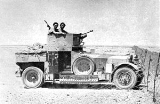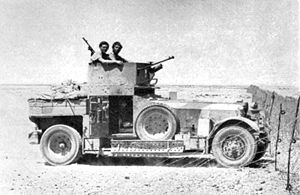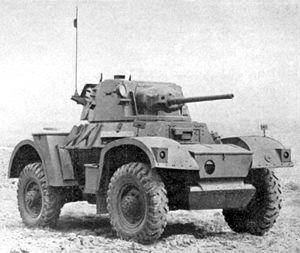
Armoured car regiment
Encyclopedia
Armoured Car Regiments were reconnaissance
units employed by the British Army
during the 20th century. The primary equipment of these units was the armoured car with many different types of armoured cars serving in the regiments during the Second World War and the Cold War
. An armoured car regiment typically numbered several hundred men and several tens of armoured cars. By the end of the 20th Century, armoured cars as front-line reconnaissance vehicles had been supplanted by tracked vehicles in the British Army and the surviving regiments converted to other organisational forms.
. Similarly equipped units of the Reconnaissance Corps
were organic parts of infantry divisions during the Second World War.
, the 12th Royal Lancers
was the sole armoured car regiment fielded by the British Expeditionary Force
. During the 1940 campaign, the 12th Lancers had an authorized strength of 38 armoured cars and about 380 men organised into a headquarters and three squadrons. This regiment served as the army-level reconnaissance asset of the B.E.F.
 In the open spaces of North Africa, armoured reconnaissance was extensively used by both the Axis and the British (and Commonwealth) forces. Changes in doctrine made the armoured car regiment an organic asset of the armoured divisions, in which role the regiments typically fielded between 50 and 60 armoured cars ranging in type from older Rolls-Royce
In the open spaces of North Africa, armoured reconnaissance was extensively used by both the Axis and the British (and Commonwealth) forces. Changes in doctrine made the armoured car regiment an organic asset of the armoured divisions, in which role the regiments typically fielded between 50 and 60 armoured cars ranging in type from older Rolls-Royce
vehicles to more modern Humber
types. Less heavily armed scout cars
were used as well. In east Africa
, the 1st East African, Kenya, and Southern Rhodesian armoured car regiments were employed by the East Africa Command.
 In 1943, the armoured car regiments were removed from the armoured divisions and used as corps-level reconnaissance assets with one regiment assigned per corps. In this role, they achieved their final organisation of a headquarters and four squadrons with 767 men. Each squadron had five troops of two Dingo scout cars
In 1943, the armoured car regiments were removed from the armoured divisions and used as corps-level reconnaissance assets with one regiment assigned per corps. In this role, they achieved their final organisation of a headquarters and four squadrons with 767 men. Each squadron had five troops of two Dingo scout cars
and two Daimler Armoured Car
s. The heaviest armoured cars in the regiments, the AEC Armoured Car
s, now mounted 75-mm cannon, a far cry from the original armoured car armament of one machine gun and one antitank rifle of 1940.
, but it was not employed in combat.
and forces in the U.K. maintained armoured car regiments whose mission remained tactical armoured reconnaissance on conventional battlefields. The 4th Queen's Own Hussars
saw combat in Malaya
from 1948-51 as an armoured car regiment. Other armoured car regiments such as the Royal Horse Guards
were deployed to Cyprus
as a result of the unrest and military events there.
The last armoured car intended for conventional battlefield use, the Fox armoured reconnaissance vehicle
, was withdrawn from active British service in 1994 and replaced by tracked reconnaissance vehicles like the Sabre
. Although reconnaissance regiments like the Blues and Royals
remain active in the British Army, they no longer operate armoured cars and hence the British forces no longer field armoured car regiments.
Reconnaissance
Reconnaissance is the military term for exploring beyond the area occupied by friendly forces to gain information about enemy forces or features of the environment....
units employed by the British Army
British Army
The British Army is the land warfare branch of Her Majesty's Armed Forces in the United Kingdom. It came into being with the unification of the Kingdom of England and Scotland into the Kingdom of Great Britain in 1707. The new British Army incorporated Regiments that had already existed in England...
during the 20th century. The primary equipment of these units was the armoured car with many different types of armoured cars serving in the regiments during the Second World War and the Cold War
Cold War
The Cold War was the continuing state from roughly 1946 to 1991 of political conflict, military tension, proxy wars, and economic competition between the Communist World—primarily the Soviet Union and its satellite states and allies—and the powers of the Western world, primarily the United States...
. An armoured car regiment typically numbered several hundred men and several tens of armoured cars. By the end of the 20th Century, armoured cars as front-line reconnaissance vehicles had been supplanted by tracked vehicles in the British Army and the surviving regiments converted to other organisational forms.
Regimental organisation in the Second World War
Armoured car regiments were a component of the Royal Armoured CorpsRoyal Armoured Corps
The Royal Armoured Corps is currently a collection of ten regular regiments, mostly converted from old horse cavalry regiments, and four Yeomanry regiments of the Territorial Army...
. Similarly equipped units of the Reconnaissance Corps
Reconnaissance Corps
The Reconnaissance Corps or simply Recce Corps was a short-lived elite corps of the British Army whose units provided the mobile spearhead of infantry divisions from the Far East to Europe during the Second World War. It was formed from Infantry Brigade Reconnaissance Groups on 14 January 1941...
were organic parts of infantry divisions during the Second World War.
France 1940
In the 1940 campaign in France and FlandersBattle of France
In the Second World War, the Battle of France was the German invasion of France and the Low Countries, beginning on 10 May 1940, which ended the Phoney War. The battle consisted of two main operations. In the first, Fall Gelb , German armoured units pushed through the Ardennes, to cut off and...
, the 12th Royal Lancers
12th Royal Lancers
The 12th Royal Lancers was a cavalry regiment of the British Army. In 1960, it was amalgamated with 9th Queen's Royal Lancers, to form 9th/12th Royal Lancers .-History:...
was the sole armoured car regiment fielded by the British Expeditionary Force
British Expeditionary Force (World War II)
The British Expeditionary Force was the British force in Europe from 1939–1940 during the Second World War. Commanded by General Lord Gort, the BEF constituted one-tenth of the defending Allied force....
. During the 1940 campaign, the 12th Lancers had an authorized strength of 38 armoured cars and about 380 men organised into a headquarters and three squadrons. This regiment served as the army-level reconnaissance asset of the B.E.F.
The war in the desert

Rolls-Royce Armoured Car
The Rolls-Royce armoured car was a British armoured car developed in 1914 and used in World War I and in the early part of World War II.-Production history:...
vehicles to more modern Humber
Humber Armoured Car
The Humber Armoured Car was one of the most widely produced British armoured cars of the Second World War. It supplemented the Humber Light Reconnaissance Car and remained in service until the end of the war.-Development:...
types. Less heavily armed scout cars
Humber Scout Car
Humber Scout Car was a British light armoured car used in the Second World War.-History:Although at the outbreak of the Second World War the British Army already had the excellent Daimler Dingo, the need for scout cars could not be met by Daimler alone, so other companies were required to produce...
were used as well. In east Africa
East African Campaign (World War II)
The East African Campaign was a series of battles fought in East Africa during World War II by the British Empire, the British Commonwealth of Nations and several allies against the forces of Italy from June 1940 to November 1941....
, the 1st East African, Kenya, and Southern Rhodesian armoured car regiments were employed by the East Africa Command.
Italy and northwestern Europe 1943-45

Daimler Dingo
-external links :*** has a Daimler Dingo in its exposition.* wwiivehicles.com**...
and two Daimler Armoured Car
Daimler Armoured Car
The Daimler Armoured Car was a British armoured car of the Second World War.-History:The Daimler Armoured Car was a parallel development to the Daimler Dingo "Scout car", a small armoured vehicle for scouting and liaison roles. It was another Birmingham Small Arms design...
s. The heaviest armoured cars in the regiments, the AEC Armoured Car
AEC Armoured Car
AEC Armoured Car is a series of heavy armoured cars built by the Associated Equipment Company during the Second World War.-History:AEC of Southall, Middlesex was a manufacturer of truck and bus chassis and its Matador artillery tractor was used for towing medium field and heavy anti-aircraft guns...
s, now mounted 75-mm cannon, a far cry from the original armoured car armament of one machine gun and one antitank rifle of 1940.
Commonwealth and other forces
Besides the British Army, the Canadians, South Africans, and Poles also fielded armoured car regiments organised along British lines and employed against Axis troops in North Africa, Italy, and northwestern Europe. Australian forces fielded the 2/11 Armoured Car Regiment2/11th Armoured Car Regiment (Australia)
The 2/11th Armoured Car Regiment was an Australian Army armoured reconnaissance regiment of World War II. The Regiment was formed in 1941 and disbanded in 1944 without seeing action.-History:...
, but it was not employed in combat.
Postwar
For decades after the Second World War, the British Army of the RhineBritish Army of the Rhine
There have been two formations named British Army of the Rhine . Both were originally occupation forces in Germany, one after the First World War, and the other after the Second World War.-1919–1929:...
and forces in the U.K. maintained armoured car regiments whose mission remained tactical armoured reconnaissance on conventional battlefields. The 4th Queen's Own Hussars
4th Queen's Own Hussars
The 4th Queen's Own Hussars was a cavalry regiment in the British Army, first raised in 1685. It saw service for three centuries, before being amalgamated into The Queen's Royal Irish Hussars in 1958....
saw combat in Malaya
Malayan Emergency
The Malayan Emergency was a guerrilla war fought between Commonwealth armed forces and the Malayan National Liberation Army , the military arm of the Malayan Communist Party, from 1948 to 1960....
from 1948-51 as an armoured car regiment. Other armoured car regiments such as the Royal Horse Guards
Royal Horse Guards
The Royal Horse Guards was a cavalry regiment of the British Army, part of the Household Cavalry.Founded August 1650 in Newcastle Upon Tyne by Sir Arthur Haselrig on the orders of Oliver Cromwell as the Regiment of Cuirassiers, the regiment became the Earl of Oxford's Regiment during the reign of...
were deployed to Cyprus
United Nations Peacekeeping Force in Cyprus
The United Nations Peacekeeping Force in Cyprus was established in 1964 to prevent a recurrence of fighting between the Greek Cypriots and Turkish Cypriots and to contribute to the maintenance and restoration of law and order and a return to normal conditions...
as a result of the unrest and military events there.
The last armoured car intended for conventional battlefield use, the Fox armoured reconnaissance vehicle
Fox Armoured Reconnaissance Vehicle
The FV721 Fox Combat Vehicle Reconnaissance was a 4x4 armoured car deployed by the British Army as a replacement for the Ferret scout car and the Saladin Armoured Car...
, was withdrawn from active British service in 1994 and replaced by tracked reconnaissance vehicles like the Sabre
Sabre (tank)
Sabre is a variation of the Combat Vehicle Reconnaissance , featuring the turret from a Fox reconnaissance vehicle mounted on the hull of a Scorpion....
. Although reconnaissance regiments like the Blues and Royals
Blues and Royals
The Blues and Royals is a cavalry regiment of the British Army, part of the Household Cavalry. The Colonel-in-Chief is Her Majesty The Queen and the Colonel is HRH The Princess Royal...
remain active in the British Army, they no longer operate armoured cars and hence the British forces no longer field armoured car regiments.

